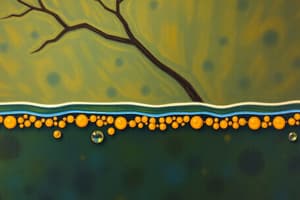Podcast
Questions and Answers
Which type of protein changes shape to facilitate the transport of molecules across a cell membrane?
Which type of protein changes shape to facilitate the transport of molecules across a cell membrane?
- Membrane receptors
- Transport enzymes
- Channel proteins
- Carrier proteins (correct)
What term describes a solution with a higher solute concentration than that of the cell?
What term describes a solution with a higher solute concentration than that of the cell?
- Hypotonic
- Isotonic
- Dilute
- Hypertonic (correct)
In facilitated diffusion, which type of protein creates a hydrophilic path allowing for ion passage without changing shape?
In facilitated diffusion, which type of protein creates a hydrophilic path allowing for ion passage without changing shape?
- Enzyme proteins
- Channel proteins (correct)
- Barrier proteins
- Carrier proteins
During osmosis, water moves from an area of __________ water concentration to an area of __________ concentration.
During osmosis, water moves from an area of __________ water concentration to an area of __________ concentration.
Which of the following describes a solution where the solute concentration is equal to that of the cell?
Which of the following describes a solution where the solute concentration is equal to that of the cell?
What is the primary characteristic of the cell membrane?
What is the primary characteristic of the cell membrane?
What type of transport involves the movement of materials from high to low concentration without using energy?
What type of transport involves the movement of materials from high to low concentration without using energy?
Which factor does NOT affect the process of diffusion?
Which factor does NOT affect the process of diffusion?
What is required for facilitated diffusion to occur?
What is required for facilitated diffusion to occur?
Which type of transport involves the use of specific proteins to move molecules across the membrane?
Which type of transport involves the use of specific proteins to move molecules across the membrane?
Which substances would have the most difficulty passing through the lipid bilayer of the cell membrane?
Which substances would have the most difficulty passing through the lipid bilayer of the cell membrane?
What occurs during passive transport mechanisms?
What occurs during passive transport mechanisms?
What type of molecule would most easily pass through a biological membrane?
What type of molecule would most easily pass through a biological membrane?
Flashcards are hidden until you start studying
Study Notes
Cell Membrane Transport Mechanisms
- The cell membrane is selectively permeable, controlling material entry to maintain the internal environment.
- Different transport mechanisms operate based on energy use: passive, active, and bulk transport.
Passive Transport
- Involves the movement from high to low concentration without using metabolic energy.
- Three main types: simple diffusion, facilitated diffusion, and osmosis.
Passive Transport: Diffusion
- Movement from areas of higher concentration to lower concentration without energy.
- Example: Oxygen diffuses from lungs into blood, essential for cellular respiration.
- Factors affecting diffusion:
- Size: Smaller particles like oxygen and carbon dioxide pass through more easily.
- Polarity: Nonpolar substances dissolve and move easily through nonpolar lipid bilayer.
- Charge: Charged particles (e.g., sodium, potassium) face difficulty crossing the membrane, despite small size.
Passive Transport: Facilitated Diffusion
- Requires specific transport proteins for faster movement of molecules.
- Mechanism allows hydrophilic and charged molecules to penetrate the lipid bilayer.
- Types of transport proteins:
- Carrier proteins: Change shape to transfer molecules securely, preventing contact with the nonpolar bilayer.
- Channel proteins: Provide a hydrophilic pathway without changing shape, allowing ions and smaller molecules to pass quickly.
Passive Transport: Osmosis
- Involves water movement from areas of higher water concentration to lower water concentration.
- Cell conditions based on solute concentration:
- Isotonic: Solute concentration is equal to that inside the cell.
- Hypotonic: Solute concentration is lower than inside the cell, potentially causing cell swelling.
- Hypertonic: Solute concentration is higher than inside the cell, potentially causing cell shrinkage.
Studying That Suits You
Use AI to generate personalized quizzes and flashcards to suit your learning preferences.




